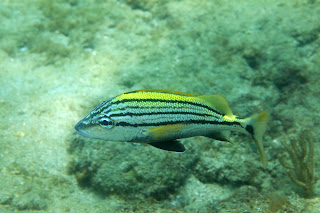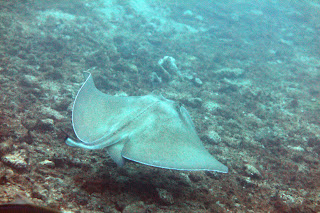 Martha and I drove to our spot behind Tower 17 and geared up. We wound around some fishermen to get in the water without tangling ourselves in their fishing line. We swam out looking for the blocks and found them. I tried to establish an intersecting line but failed to take a picture, so I'm not sure that I will be able to find it again. Still, we started our dive at the blocks. Went up the gun sight to Irish thighs then the Cigar Rock and finally to the Gray Mid-Way Rock.
Martha and I drove to our spot behind Tower 17 and geared up. We wound around some fishermen to get in the water without tangling ourselves in their fishing line. We swam out looking for the blocks and found them. I tried to establish an intersecting line but failed to take a picture, so I'm not sure that I will be able to find it again. Still, we started our dive at the blocks. Went up the gun sight to Irish thighs then the Cigar Rock and finally to the Gray Mid-Way Rock.
Got some pictures of a small school of Atlantic Spadefish, a number of grunts, Snappers and other common fish. We swam to the Big Coral Knoll, but there were no turtles there and not a lot of fish, either.

a French Grunt (Haemulon flavolineatum)
A Caesar Grunt (Haemulon carbonarium);

A Bluestriped Grunt (Haemulon sciurus);

A Gray Snapper (Lutjanus griseus)

A Spanish Grunt (Haemulon macrostomum);

A Schoolmaster (Lutjanus apodus);
and a Small School of Ballyhoo (Hemiramphius brasiliensis).
We went looking for the smaller knoll to the NE, but I turned back without finding it. We headed back to the Fish Camp Rocks and then headed West to the beach.
Bottom time was 130 minutes, our maximum depth was 19.2 ft. My SAC was 14.41 psi/minute and an RMV of 0.37 cubic feet per minute.




















